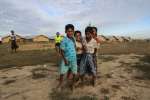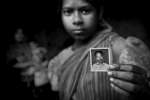UNHCR assists flood victims in Myanmar's Rakhine and Kachin states
News Stories, 4 August 2015
GENEVA, Aug 4 (UNHCR) – Cyclone Komen which swept across western Myanmar last week has caused extensive damage, including to areas where thousands of displaced people are living, the UN refugee agency said on Tuesday.
Strong winds, heavy rains and serious flooding are still hampering assessment and relief efforts, but teams of UNHCR, other UN and NGO staff have so far managed to reach camps for internally displaced people in Rakhine's provincial capital Sittwe, as well as in nearby townships such as Pauktaw and Myebon.
"In 24 camps assessed so far, a quarter of the temporary shelters are damaged, and more than 21,000 displaced people affected as a result. Several years on from their construction, many of these shelters had become fragile and unable to withstand severe weather," UNHCR spokesperson Adrian Edwards told a press briefing in Geneva.
He said that UNHCR and its partners were still assessing the impact on the existing displaced populations in Rakhine and Kachin states, with a view to identifying immediate needs and distributing relief.
Rakhine state has been declared one of four 'natural disaster zones' by the Myanmar Government, alongside Chin state and Sagaing and Magway regions.
UNHCR teams are also currently assessing needs in camps for the internally displaced in Minbya, Mrauk-U and Kyauktaw.
"These areas are accessible only by boat and we were able to go yesterday (Aug 3) after clearing debris from waterways. Once the assessments are completed UNHCR will distribute relief aid," Edwards added.
In Maungdaw township, over 2,000 households have been affected. However, in the last few days, receding flood waters have allowed many evacuated families to return home.
UNHCR has distributed relief aid including tarpaulins, blankets, mats and buckets to those hosted in official reception centres as well as others who have been affected.
Parts of Buthidaung township remain underwater. UN and NGO staff have reached 68 villages so far and found over 18,000 people displaced by the floods.
"As assessments continue, we are distributing tarpaulins and mats to those affected," Edwards noted.
In Kachin state, home to over 100,000 conflict-displaced people, the impact of recent rains and floods has been less extensive. At the government's request, UNHCR and partner agencies have examined conditions in Mogaung township. Of the four IDP camps visited, one was flooded and nine displaced families were relocated.
UNHCR's assistance to people affected by the cyclone and floods is part of a wider inter-agency response to support the Myanmar government's relief UNHCR continues to work with the authorities to find longer-term solutions to situations of internal displacement.
By Vivian Tan/Andreas Needham, ed. Jonathan Clayton








































































